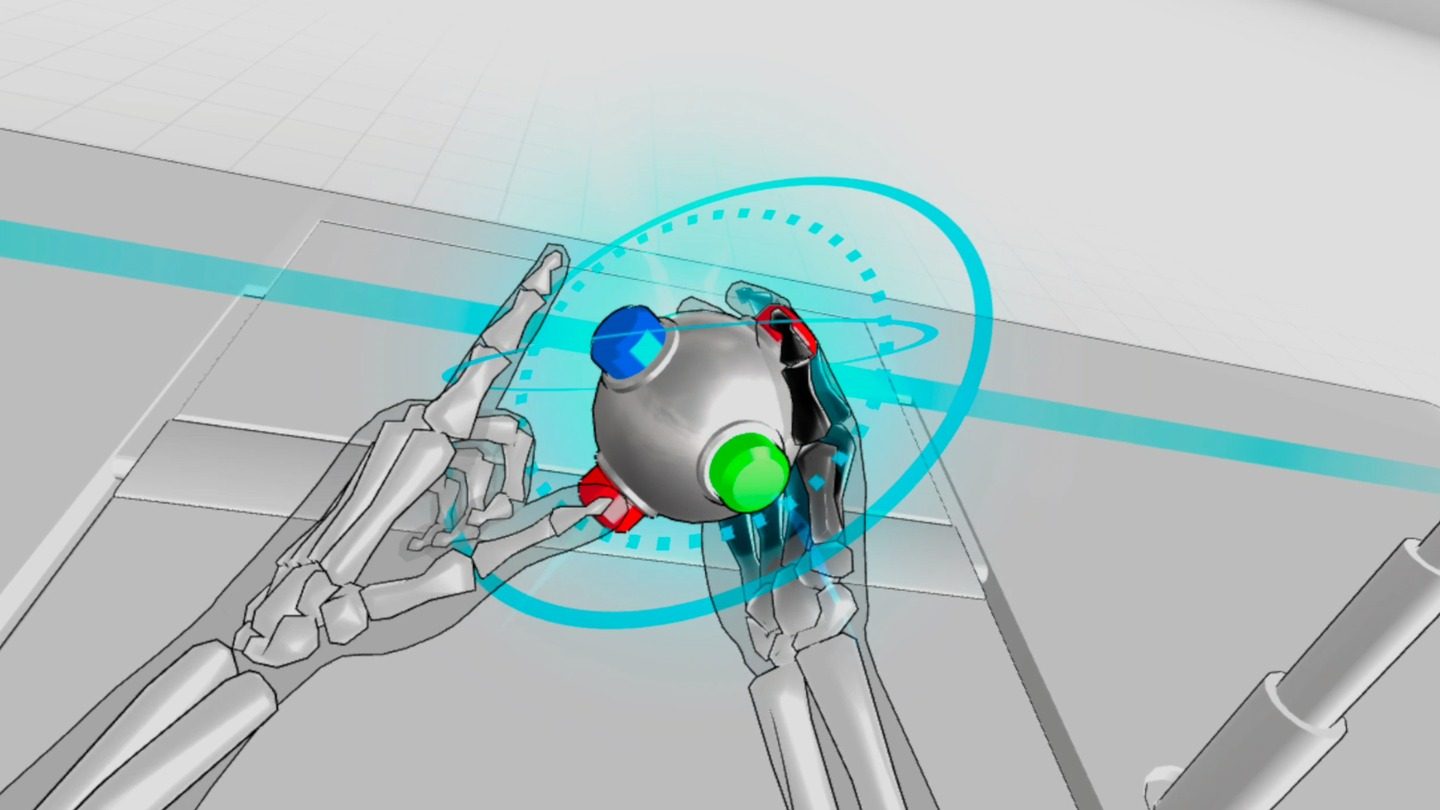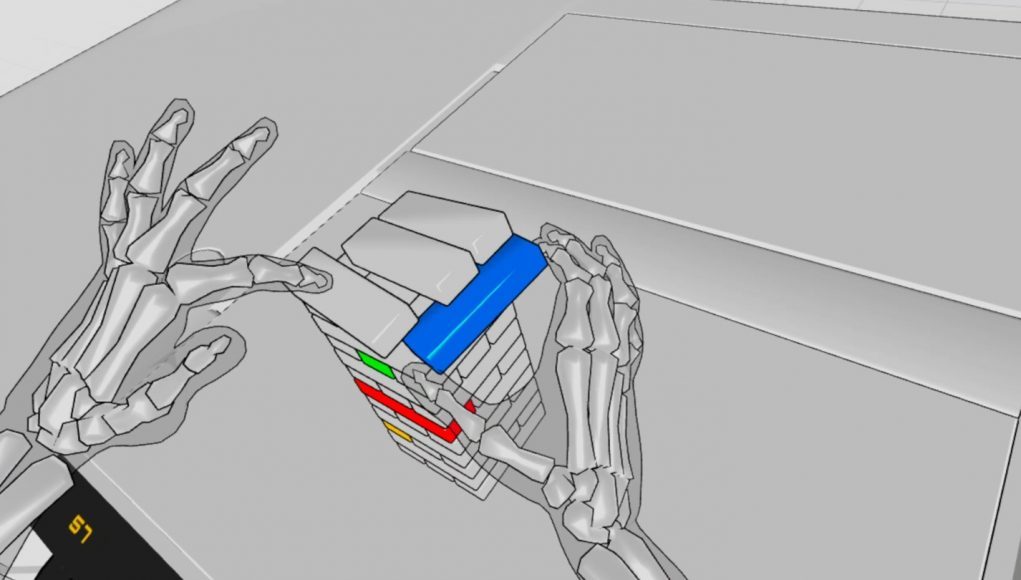Hand Physics Lab is all about hand-tracking, and this over 80-level game aims to throw you head first into a whimsical series of seemingly simple tasks. Quest can offer mixed results when it comes to hand-tracking fidelity though, so if you’re not careful, it can be extremely frustrating for all the wrong reasons.
Hand Physics Lab Details:
Available On: Oculus Quest
Release Date: April 1st, 2021
Price: $10
Developer: Dennys Kuhnert – Holonautic
Reviewed On: Quest 2
Gameplay
Messing around with hand-tracking is really fun the first couple times you try it, and seeing my twiddling fingers represented in VR really served up some of the first ‘wow’ moments for me. Despite the promise of controller-less interactions, hand-tracking on Quest hasn’t been adopted by game developers across the board for a few reasons, a major one being that it offers lower fidelity input in comparison to Touch.
Note: If you haven’t given hand-tracking a spin on either Quest headset, you just need regular indoor lighting for optimal results. I found closing my shades and turning on all my interior lights provided adequate tracking. Still, it’s not uncommon to see your virtual hands completely wig out, or not track all of your fingers correctly—it just doesn’t feature the rock-solid tracking and button inputs of Touch.
Because Hand Physics Lab has virtualized your hands into physics-based objects, it’s less about directly interacting with objects and more about carefully miming actions and piloting a pair of decidedly much less capable limbs. It feels a bit like playing Surgeon Simulator at times, except the fidelity of input is constantly changing. It’s hard to predict when hand-tracking will fail and that lightbulb you tried to screw in for the past five minutes gets launched into the stratosphere.
Hand-tracking funkiness is an Oculus problem, but Hand Physics Lab seems to be leaning into it with mixed results. Even in the best case, this is the level of jitter you should expect. Keep an eye on the left hand as the fingers and whole hand pulse. In the worst case, your hand won’t work. Like at all.
Ok, so maybe it’s comically difficult by design because the hand-tracking control scheme isn’t precise. Hand Physics Lab also offers Touch controls, but that feels a bit like cheating because it lowers the skill ceiling so low that it’s not really even worth playing at that point. The creator assumes you’ll want to play with hand-tracking, so I did.
And like Surgeon Simulator, it definitely results in some madcap things like getting your virtual arm stuck in a tube while your physical hand moves through space unimpeded. When it’s working well enough it can be really fun, but when you’re not sure why hand-tracking is failing and it just does, playing the game can feel like trying to punch someone in your dreams. Totally ineffectual for no discernible reason.

In Hand Physics Lab you run through about 80 tasks, most of which are regular things even chimps are expected to be able to do: Press these buttons. Sort these colored blocks. Stack these colored blocks. Paint these eggs different colors. And although only some that can be considered puzzles as such, there are a few really interesting tasks in the bunch that take some patience and attention to accomplish, like having to snatch target blocks out of a tumble dryer, or using a sort of grip-based telepathy to guide blocks through a series of tubes.
After completing the final sequential task, I was pretty much done with Hand Physics Lab though. Its more of a quirky, bright smorgasbord of tech demo stuff than a full-featured game as such. I say that full-well knowing that there’s actually a fair bit of content here; you play sequential levels to earn stars in order to unlock sandbox activities.
Putting hand funkiness aside, I wished offered bigger and better puzzles. There was a glimmer of some really interesting tasks that very briefly ramped up to real puzzle territory, and I would have loved to see those teased out more.
Immersion
At risk of repeating myself, I’ll put it this way: hand-tracking funkiness really inhibits the promise of this game. If hand-tracking on Quest were hypothetically rock solid, and this game intentionally made it tremble and wig out for comedic effect, you might appraise it differently.
Anyway, I typically would play around 10 minutes at a time, but after playing for an hour straight, I got extremely frustrated with the game (read: I rage quit I tactically regrouped) and I had to write down my immediate impressions:
I feel like I have a wasting disease writing this. I just played Hand Physics Lab for an hour straight, and now my hands feel like weak meat puppets.
I’m having to concentrate very hard to coordinate my hands to type this correctly, and my arms feel extra heavy and useless.
The game had screwed with my proprioception, or the sense that you know where your limbs are at any given time without looking at them. More accurately, I was actually experiencing a ‘body transfer illusion’, which can be replicated by hiding a person’s hand from sight and replacing it with a fake one. Stroking both the fake hand and the subject’s real hand with a feather actually creates something called ‘proprioceptive drift’, which essentially makes the person feel like the rubber hand is their actual hand.
Because I was so intently staring at my virtualized hands the entire time, which don’t move perfectly in concert with my physical hands, I had actually internalized that my hands had become less effective at fine coordination tasks like typing or picking things up afterwards when I left the headset. Revisiting the game for shorter periods made this less apparent, but it’s safe to say I won’t be playing for extended sessions anytime soon. I took a break after that, and my arms eventually felt normal again, which was a relief.
Smaller bites and slower, more intentional movement can lessen this, but just don’t go in expecting to interact normally.
Comfort
Hand Physics Lab can be played seated, standing, and allows for a variable amount space. Besides the intensely weird body illusion stuff, it ranks among the most comfortable VR experiences since all locomotion is physical and not artificial such as smooth turning, snap-turning, or teleporting.







